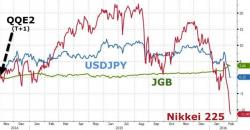This Is Wall Street At Its Most Fatalistic: "Markets Are Now Coupled In A "Destructive” Way"
The text that follows may be the best summary of what has happened on Wall Street - both forensically and philosophical - over the past 7 years, explaining how central banks broke the "market", and why traders, investors, regulators, policy makers, and everyone else suddenly has no idea either what is going on or what to do next. Not surprisingly, it comes from Deutsche Bank, which this week has been staring at the corpe of Lehman Brothers and wondering if it is next...
From DB's Aleksandar Kocic
Asphyxiation -- code orange?

